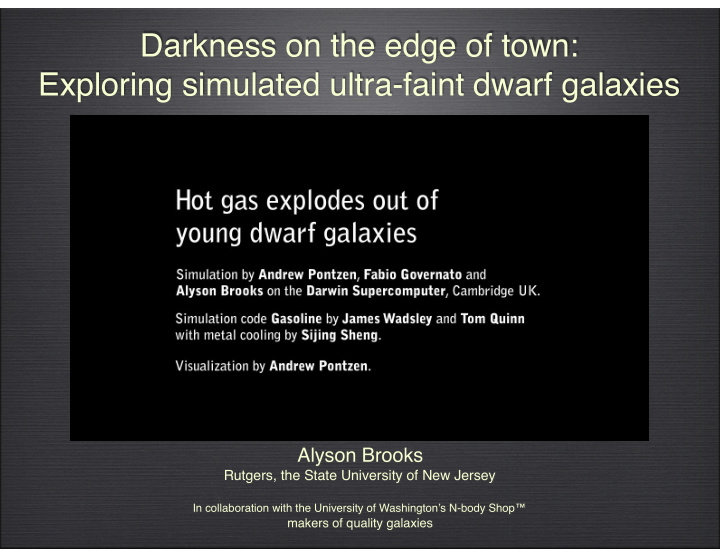



Darkness on the edge of town: Exploring simulated ultra-faint dwarf galaxies Alyson Brooks Rutgers, the State University of New Jersey In collaboration with the University of Washington’s N-body Shop™ makers of quality galaxies
Darkness on the edge of town: Exploring simulated ultra-faint dwarf galaxies “ Dancing in the Dark: Uncertainty in ultra-faint dwarf galaxy predictions from cosmological simulations”, Munshi et al. ApJ, 2019, 874, 40, arXiv:1810.12417 , “Darkness on the edge of town: Simulated ultra-faint dwarfs in a MilkyWay context,” Applebaum et al., in prep
The Faint Galaxy Boom J. Simon, ARA&A (2019)
The Future is Dwarfy Tollerud et al. (2008) Fainter Brighter see also Walsh et al. (2009); Newton et al. (2018)
Will We Understand What We’ll Find? • What is the lowest mass halo that contains a galaxy? (talks next session) • Stellar Mass to Halo Mass? Scatter? • Occupation fraction? • Today’s talk: the role of star formation prescription MC (high density/low temp) vs H 2 (follow molecular hydrogen)
First: Why Simulators Generally Don’t Worry About This Benincasa et al. (2016)
Self-Regulation in Classical Dwarf Galaxies M star ~ 10 8 M ⦿ Christensen et al. (2014)
z=0 DM density The Goal: Hundreds of Simulated Dwarf Galaxies to Interpret Local Volume Studies z=0 Gas density
The Marvel-ous Volumes Captain Rogue Marvel Elektra Storm Force resolution: 60pc Many flavors: DM only SPH resolution: 6pc - With H2 + Black Holes - M star : 400 Msun Metal cooling + self shielding - M dm : 6000 Msun SIDM - z~129 to 0
The Role of Star Formation Prescription Munshi, Brooks, et al., 2019, ApJ, 874, 40
The Role of Star Formation Prescription Munshi, Brooks, et al., 2019, ApJ, 874, 40
The Role of Star Formation Prescription Munshi, Brooks, et al., 2019, ApJ, 874, 40
Take Away (Part I) • UFD properties are strongly dependent on chosen prescriptions of simulators, unlike in classical dwarf range • This is because UFDs are strongly affected by external factors (reionization) and can no longer self-regulate.
The DC Justice League 4 volumes centered on MW-mass halos @ z=0 @ z=0 Elena Sandra Sonia Ruth Force resolution: 170 & 85pc M star : 8000/1000 Msun SPH resolution: 17 & 9pc M dm : 1.3x10 5 /1.6x10 4 Msun z~to 0
Satellite Luminosity Functions Elena: 0.75 x 10 11 M sun Sandra: 2 x 10 12 M sun Applebaum, Brooks, et al., in prep
Size-Mass Relations Applebaum, Brooks, et al., in prep
Unlike Dwarf Environment, no dependence on Star Formation Dwarfs i.e., need Milky Way sims to avoid these issues!
Metallicity as a Test Observational metallicity floor Agertz et al. (2019)
Metallicity as a Test preliminary Applebaum, Brooks, et al., in prep
Conclusions 9 out 10 simulators agree: we can now form realistic classical dwarf galaxies (thanks to self-regulation) Self-regulation breaks down in ultra-faints (strongly affected by feedback/reionization) Caveat emptor: simulation prescriptions lead to differing results based on the environment the ultra-faint resides in. To understand UFDs around the Milky Way, need Milky Way-mass simulations (challenging!) Metallicity distributions of ultra-faints may point us to the conditions of star formation in the early Universe
Recommend
More recommend